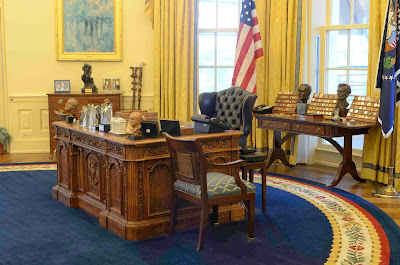Before we went to the museums, threats of severe weather drove us out of the motorhome shortly after we parked in Little Rock.
We were in a campground facing the Arkansas River and right across from the city with a wonderful view and a great spot to watch the incoming storm. But first, we took our 10K volkswalk about town.
We started at the Clinton Walking Bridge located next to the campground. The bridge leads across the river to the Clinton Presidential Library and to the wetlands built nearby.

Following the trail from the library took us to the River Market district and the wonderful sculpture gardens. This area is an excellent example of well-used redevelopment money, a park for all to enjoy with play space and an amphitheater.

We re-crossed the river at Junction Bridge and went into Argenta where we found a market that specializes in local products. We then returned to the motor home to await the storm.
Fortunately, the storm hit south of us and we only had a little rain during the night. That meant we could get back out in the morning, this time to more museums with mixed reviews.

We returned to the Clinton Library. The opening film, narrated by the former President, reviewed his life and values. It concluded with his early political life in Arkansas.
Displays divided by topics such as politics, foreign affairs, the economy and health care, told of the challenges and successes of his eight years in office.
As in other presidential libraries, this one too has a replica of the Oval Office as it was set up during Clinton’s terms.
The Presidential Seal is on the ceiling.
Nearby display cases are filled with mementos of national and international origin. The museum is patterned after the Trinity College Library in Dublin. Remember that photo, Sandy?
This is a section of a Dale Chihuly sculpture that hung in the White House in the 1990s.
Presidential museums are wonderful places to learn the highlights of a presidency. What they don’t mention is the next step: did this program continue, was it successful, is this treaty still in force? Because his presidency is so firm in our memory and what he faced continues today, it is difficult to ignore what we know now when looking at Clinton’s (or any president’s) term. The only library we have been in that is self-critical is the Nixon one and he was dead by the time the Watergate section was added. These libraries are repositories of vast documents but it seems only researchers learn the whole story. For younger visitors, we can only hope the teachers go beyond the labels to teach the greater story.
After a delicious lunch at Flying Fish, we went to the institution that made Little Rock infamous.

In 1957, nine courageous African-American teenagers marched up the steps of Central High School, the first non-white students to attend the school. Then Governor Orval Faubus brought in the National Guard to defy the order of the Supreme Court and stop them. He also called on the citizens of Arkansas to come and prevent desegregation from happening in their schools. President Eisenhower stopped the action of the National Guard troops and had the students escorted by Regular Army troops to class. This picture hanging on the wall of the Visitors Center tells it all.
The students continued to attend class but were harassed verbally and physically every day. In the 1958-59 school year, Faubus closed the school. That action was declared unconstitutional and the school reopened and the nine each graduated from the high school. It is interesting to note that the passage of the Civil Rights Act of 1964 made receipt of federal education funds contingent on desegregation. That ended the protests.
Central High is still going strong. Across the street from it, the story of 60 years ago is part of an excellent National Historic Site. Across the street from Cental High is a 1950s era Mobil Oil gas station that is now part of the education center.
Visual displays are supplemented by audio narratives from those who participated and witnessed this significant civil rights event. An old movie, made within a few years of their graduating, tells about the nine students and where they went on to college (except the one who got married). We learned from the ranger that one of them has died and that two have returned to live in Little Rock. There was a personal poignance to this story. We were the same age as these students, yet lived in such a different world. Their story was TV news to us. This museum continues to make their story relevant and meaningful.
On our return to the campground we had a wonderful (and too rare) experience. From the next site over, neighbors invited us to join them along the riverside. We had such a delightful conversation with Glenn and Lynn that we all went out for a great dinner at Ristorante Capeo. We talked as if we had been friends for years, covering travel, RV life, theater, museums, family and a bit of politics. We plan on meeting again along the road.
Though there was more to enjoy in Little Rock, we had to get on the road to Walmartland.













No comments:
Post a Comment